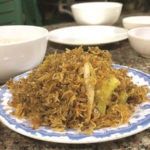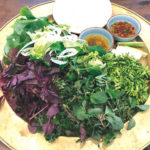Gwendal Poullennec, International Director of the Michelin Guide, told The Hanoi Times that the awarding of four Michelin stars to Vietnamese restaurants marks a new era for Vietnam’s cuisine.
An independent and transparent review process is essential for ensuring fairness and accuracy.
Following the award ceremony, there has been an intense discussion among the locals regarding the quality of some of the starred restaurants, the exclusion of banh mi, and the fact that Hanoi has more Michelin-starred restaurants than those in Ho Chi Minh City. What are your opinions on this?
I am delighted that the Michelin Guide has received so much attention from the public. I believe that the debates and discussions about the Michelin list will help experts become more aware of the local cuisine, and the Michelin Guide will ultimately elevate Vietnamese cuisine to the international culinary map.
As for comments on social media that unfair reviews or relationships may affect the outcome of the selection, I honestly don’t care.
| Gwendal Poullennec, International Director of Michelin Guide, announced honored restaurants. Photo: Ngo Minh/The Hanoi Times |
Yes, I’d love to explain how the Michelin Guide inspectors work. These inspectors have a vast knowledge of the culinary world and are experts in their field. They travel to different restaurants, tasting the dishes and evaluating the overall quality of the experience. The inspectors take into account the quality of the ingredients, the preparation, the presentation, the service, and the ambiance when making their assessment. Once they have gathered all of the information, they compile their reviews and ratings, which are then presented in the Michelin Guide.
The Michelin Guide has an independent review process, separate from the restaurants. Our team of inspectors are culinary experts from many cultures who work full-time for the Michelin Guide.
We have been observing Vietnamese cuisine for a long time and have noticed the stability and identity of the restaurants here. So, last year, evaluators came to experience and evaluate the cuisine. Not only did they enjoy meals in restaurants, but they also spent time learning about local customs and culture to gain knowledge and understanding of Vietnamese cuisine.
The inspectors work anonymously to prevent any external influences from affecting the results. Several inspectors visit each restaurant, but each inspector only visits the restaurant once to maintain transparency.
The final score results from a group of inspectors, not an individual. We do not use opinions on social networks or media as a criterion in our evaluation process. We guarantee that a one-star restaurant in Ho Chi Minh City, Tokyo, or Paris is of the same quality.
In addition, we have no bias or quota in our search for restaurants in these two cities. The fact that Hanoi has three Michelin-starred restaurants and Ho Chi Minh City has only one is because the appraisers choose only restaurants with good food, not where the restaurant is located.
Is it true that the Michelin Guide will revoke stars from restaurants that fail to maintain their level of excellence, or remove them from the list entirely?
It is not enough for a restaurant to simply be listed in the Michelin Guide; they must maintain the highest quality standards and consistently provide an exceptional dining experience to their customers. If the quality of their food or service diminishes, they will no longer be included in the Michelin Guide.
It is much more important for restaurants to cultivate lasting relationships with their customers than to try to impress Michelin Guide reviewers.
A sushi restaurant in Japan that has been awarded three Michelin stars has seen a surge in customers since the star was awarded. Due to the large number of guests, the restaurant only accepted groups of VIP guests or those who were already acquainted with the restaurant. Despite the quality of food remaining the same, the diner’s experience is no longer what it used to be, so the Michelin stars have been withdrawn.
A Platform for Promoting Vietnamese Cuisine
Being included in the Michelin Guide and awarded a Michelin star is a huge honor for any Vietnamese restaurant. It represents a recognition of their high-quality food, refined culinary techniques, and excellent service. The Michelin star is an international symbol of excellence and is highly coveted by chefs and restaurateurs worldwide.
The Michelin Guide has a team of appraisers from 20 countries. The Guide is present in more than 40 countries and regions. The prestigious Michelin star is like a passport for restaurants, providing them the opportunity to reach out to the world, explore different styles of cooking and express their personalities. Furthermore, the star is beneficial to the local tourism industry as starred restaurants tend to attract more visitors, and those visitors stay longer and spend more.
The Michelin star is an honor for a restaurant and a reference channel for diners. Many people look forward to enjoying food at Michelin-starred restaurants. As the number of guests increases, so do the demands and expectations. To meet these demands, restaurant owners must make efforts to improve the service, thus leading to a more and more developed food quality.
I believe that the Michelin Award will give impetus to the Vietnamese culinary industry because chefs from abroad will also want to open a restaurant here.
| Vietnamese cuisine is expected to be promoted to the world through Michelin Guide. Photo: Ngo Minh/The HanoiTimes |
I personally rate the cuisine in Hanoi and Ho Chi Minh City, the first two Vietnamese cities to be evaluated by the Michelin Guide, very highly.
Hanoi is a city of relaxation and calm, with small shops and restaurants to be found in abundance in the Old Quarter. Here, you can experience the bold flavours of traditional Northern Vietnamese cuisine, with freshness, spices and herbs combining to create unique dishes.
Meanwhile, Ho Chi Minh City is a vibrant and fast-growing city that always offers visitors a unique energy source with a diverse cuisine. Modern and traditional cooking techniques are clearly displayed, with great coordination between experienced and young chefs visible through the ideas and creativity expressed in the dishes.
The two localities have different typical dishes, but in general, both contribute to regional and global cuisine.
In Vietnam, young people are increasingly turning to social media influencers to determine which restaurants they should visit. How can the Michelin Guide be appealing to this demographic?
It appears that the award of the first-ever Michelin Guide to Vietnam has been met with controversy on social media, suggesting that even young Vietnamese people are taking an interest in the esteemed Michelin Guide.
I want to tell you that I once went to a restaurant near the Forbidden City in Beijing, and I was 38 years old and the oldest customer that year.
I think Michelin has a great influence on people of all ages. Qualified restaurants are listed on all of Michelin’s social media platforms, so young people are sure to reach them.
Thank you for your time!










